
33 minute read
Full story
ousands of farmers may lose payment support
Many farmers could be without an agri-environmental payment next year, despite news that a new agrienvironmental scheme is to open later this summer.
Advertisement
Applications to the new agship €1.5bn scheme that will replace GLAS will open this summer, according to Agriculture Minister Charlie McConalogue. However, in a response to a query from the Farming Independent on whether the new scheme would be able to accommodate all farmers currently in GLAS, the Minister said: “I am exploring all options to ensure that no farmer currently in GLAS, who wants to join the new scheme, will be without an agri-environmental scheme payment as we transition from GLAS to the new programme.
“It’s crucial that we get as much continuity as possible.”
It is feared that thousands of farmers could be a ected. e Agri-Environment Climate Measure (AECM) will be a results-based scheme and will o er a maximum payment of €7,300 to farmers generally and €10,500 to those who adopt co-operation projects in high-priority geographical areas.
IFA President Tim Cullinan said the new scheme was far from a ‘new REPS’, is “extremely complicated” and will exclude many farmers.
“ e Government and the Minister have been trying to spin this as a ‘REPS-type scheme’ since it rst appeared in the Programme for Government,” he said.
“However, it has little or nothing in common with the original Rural Environmental Protection Scheme (REPS).” e AECM proposes to have up to 50,000 farmers participating and it is planned to open the scheme over at least two tranches, which IFA says could cause a lag in payments. e IFA presidnet in conclusion said: “I am calling on the Minister to ensure no farmer is without an environment scheme payment for 2023.”
War, in ation worries for consumers as savings fall
In the second quarter of this year, Bank of Ireland’s Savings and Investment Index dropped signi cantly (to 90 from 96 in February), with consumers now citing the war in Ukraine (32%) and in ation (22%) as their biggest worries. ere has been a signi cant drop in consumers who are saving regularly (40% in May compared to 47% in February) and investor con dence has dropped as markets fell back.
Consistent with international surveys, Covid has dropped rapidly from the list of top concerns, cited by just one in 20 as their biggest concern, below cost of housing (13%), climate change (11%) and global recession (11%). is signi cant shift has in uenced how Irish consumers view their savings and investment plans. e index also pointed to signi cant di erences in concerns between generations (see above). In ation/cost of living is most signi cant amongst the core working age population (ages 30-59), 27% of whom cite it as their biggest worry, while this drops to 21% amongst 16-29 year olds. In contrast, amongst those aged 60+, just 15% cited in ation/ cost of living as their main worry, with 46% seeing the war in Ukraine as their main concern. One in four of under 30s are most worried about the cost of housing and rent.
During the pandemic, the Savings Index had risen considerably reaching a high of 108 in March 2021. At the end of last year, attitudes to saving looked to be normalising but this has given way to a much greater focus on the cost of living and the Savings Index has now dropped to 91, its lowest level since prepandemic times.
With in ation rising, there was a signi cant drop in the proportion of consumers saving regularly this quarter (40% v.. 47% in February 2022). e survey results suggest consumers are possibly dealing with in ation by dipping into their savings and also recognise that with interest rates at near zero, savings may lose real value.
Less than four in 10 (38%) of consumers now think it’s a good/very good time to save, which is back to the level seen in February 2020 before Covid drove up savings (the peak stood at 55% in May 2020).
According to Kevin Quinn, Chief Investment Strategist at Bank of Ireland: “ e signi cant increase in in ation in the past quarter has led a lot of consumers to re-think their savings habits. e results of our May survey suggest that consumers are both deeply concerned by the tragic events in Ukraine but also very focused on the cost of living challenges now a reality for so many families in Ireland.”
When asked to look forward six months, these same consumers are somewhat more optimistic with just 32% believing it will remain a bad/very bad time to invest and 29% believing it will be a good/very good time to invest. Despite this, 53% believe they are not investing enough, which is only 2% lower than February ’22 and higher than most scores since 2019.

We still come out clean with Euro litter award
e latest survey by Irish Business Against Litter (IBAL) shows Kilkenny retaining its ‘Cleaner than European Norms’ status, rising to 8th in the ranking of 40 towns and cities. e An Taisce report acknoweldged the fact that Kilkenny is consistently highranking and noted that this ‘takes a lot of work on the part of many within the community with all approach roads got the top litter grade, creating a positive rst impression.
Final call to Kilkenny artists for Zurich entries
e National Gallery of Ireland has announced the judges for the 2022 Zurich Portrait Prize and Zurich Young Portrait Prize competitions. Judges for the Zurich Portrait Prize are Anna O’Sullivan, Director of the Butler Gallery, Kilkenny; Nick Miller, artist; and Diana Copperwhite, artist (pictured above).
Judges for the Zurich Young Portrait Prize are Una Sealy RHA, artist; Nick Roche, comic illustrator and Janet McLean, curator, National Gallery of Ireland. e closing date for entries to the Zurich Portrait Prize and Zurich Young Portrait Prize is June 22.
For the Zurich Portrait Prize, the competition showcasing contemporary portraiture, the Gallery invites submissions from across the island of Ireland, and from Irish artists living abroad. e Zurich Young Portrait Prize, now in its fourth year, is open to young people aged 18 and under. e Zurich Portrait Prize aims to encourage interest in contemporary portraiture and to showcase the National Portrait Collection at the National Gallery of Ireland. e winner of the competition will receive a cash prize of €15,000 and will be commissioned to create a work for the national portrait collection, for which they will be awarded a further €5,000. Two additional awards of €1,500 will be given to highly commended works. e Zurich prize, which aims to foster and support creativity, originality and self-expression in children and young people returns for its fourth year in 2022. e competition is split into four age categories and is open to young people of all abilities aged up to 18 from across the country. Winners in each age category and an overall winner will be chosen from a shortlist of 20 works. Winners will receive a bespoke art box and a cash prize.
Exhibitions featuring shortlisted works in both competitions run at the National Gallery of Ireland between November 26 and April 2, 2023. e exhibitions will then travel to Donegal where they will run at Regional Cultural Centre in Letterkenny from June 3, 2023 to September 2 2023. is is the rst time that the competition exhibitions will be on display in Ulster.
Highly commended artists and an overall winner for the Zurich Portrait Prize, as well as category winners and an overall winner for the Zurich Young Portrait Prize, will be announced in early December 2022, after the exhibitions have opened at the Gallery.
Find out more at www. nationalgallery.ie.
Two jailed for ‘horrendous’ cruelty to dogs
Two men have been jailed for four months for neglecting 56 dogs that were living in “horrendous conditions” in Co Waterford.
In Dungarvan District Court on May 13, 2022, Judge Brian O’Shea handed down fourmonth custodial sentences to Patrick and Michael O’Brien of Monaman, Lismore, Co. Waterford who had pleaded guilty to o ences under the Animal Health and Welfare Act (AHWA) 2013.
Both brothers have also been disquali ed from owning any dogs for life and were ordered to pay costs of €1,330 and €1,979 in veterinary fees. In September 2020, ISPCA Animal Welfare Inspector Alice Lacey followed up on a report from the local dog warden regarding the O’Brien’s premises.
Ms Lacey said it was one of the worst cases of animal cruelty she had ever come across, as the dogs had no natural light, little ventilation, little access to water, and there was a build-up of faeces in the premises. e dogs were also su ering from a range of health issues including untreated skin conditions, malnourishment, bite wounds and matted coats which were caked in faeces and urine.
A number of the dogs were also blind which it was believed was as a result of inbreeding and most of them were feral and terri ed of human contact.
“ is was an extremely challenging and distressing case to deal with in terms of the number of dogs and the severity of their su ering,” Ms Lacey said.
“ e smell was indescribable and the living conditions were horrendous.
“It is so very di cult to comprehend how anyone could let a situation get so out of hand and let so many animals su er.
“ e majority of dogs were not used to being outside in fresh air, and shuddered at any sign of human touch. “Despite what we had experienced – just a snippet of the dogs lives before intervention and rescue, it was miniscule compared to what I believe, was an existence of desperation and hopelessness for these animals.
“Unfortunately, they were completely powerless with regard to their upbringing and the result of that came in the form of one of the most tragic and upsetting cases of animal cruelty I have ever come across, in my time as an Animal Welfare Inspector”.
She added that due to the severity of their physical and psychological states, many dogs were euthanised to end their su ering. e others were rehabilitated after spending considerable time in ISPCA care and have now gone to loving homes.


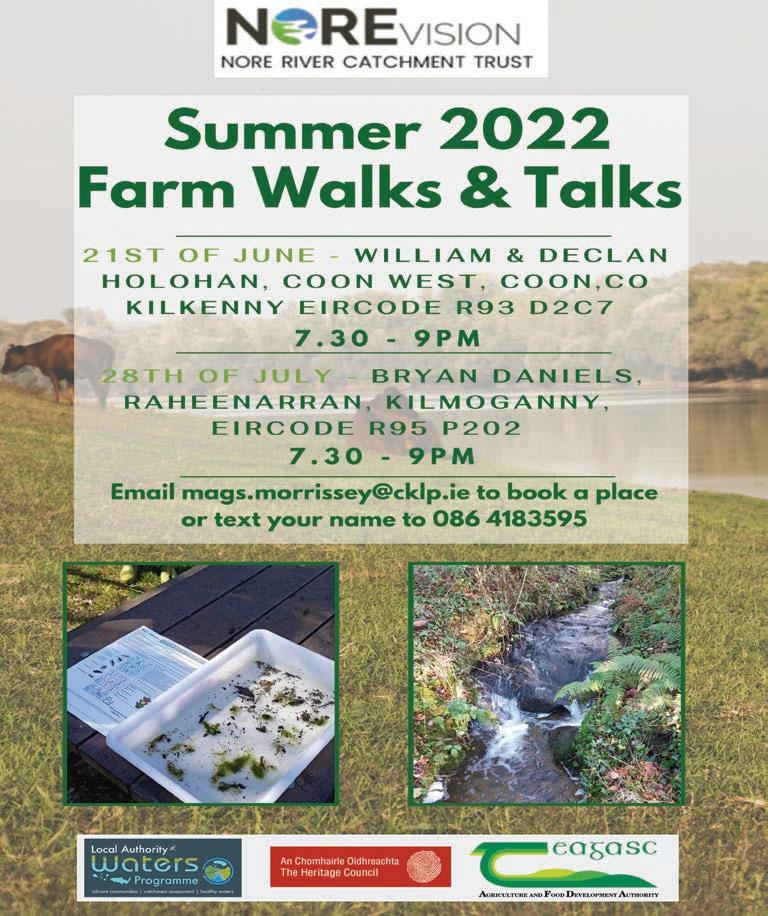

is week in e Kilkenny Observer, Cois Céim in association with e Saturday Walkers Group, takes a look at the life and times of one of Kilkenny’s well-known characters from Walkin Street by the name of Bryan Reilly
In the 1830s there lived in Walkin Street a man named Bryan Reilly. He occupied the house for over forty years, which was in later years (1880s) a stone cutters yard. No one knew who he was or where he came from as he never claimed a relationship with anyone. He wore a piece of cloth folded like a turban round his head which gave him an Oriental appearance. Indeed it was widely believed he originally had been a Turk, had settled here and assumed the name Bryan Reilly to conceal his origin. His house consisted of two large rooms on the ground oor, the inner one served his domestic needs. e outer one was his ware house or store in which he carried on all his transactions. To understand the details of his stock it is necessary to know the class of merchants from whom he purchased his goods. ere was nothing ever o ered him for sale that he did not o er something in the shape of money to purchase. As a result of this trade he had on his hands every roughish servant, apprentice, and assistant in the city, as he was sure to o er them something no matter what it was they could pilfer from their masters, mistresses or employers. A result of the merchant’s rule of business was that his stock in trade consisted of the most varied materials ever piled over each other on the oor as there was neither counter nor shelving in the ware room. In this pile on the oor was broken bottles, horse shoes, balls of twine, crockery ware, arithmetic’s, boots, shoes, and brogues without heels, and cobblers lasts. ere was Carpenters tools, ‘Reading made easy’ without covers, thimbles, brushes, kettles, tea pots without spouts, pewter plates, candle sticks, bundles of tape, and bags of marbles. In fact his museum was stored with something of everything under the sun. Every drunken tradesman in the city was sure to visit this repository of curiosities on a Monday morning where they deposited their tools for the rst three days of the week. e old hedge school masters of the county formed an important part of his business as he always had a large stock of old school books which he readily bought up from the mitching urchins of the city. For nearly forty years he carried on the business. None of his customers were ever admitted within the precincts of his sale room, for whether the weather was wet or dry the party selling or buying should stand in the street and carry on the business over the half door.
SPECIAL PLACE FOR ECCENTRICS AT THE HALF DOOR
No person lived in the house but himself, and he entertained a special regard for the eccentrics of the
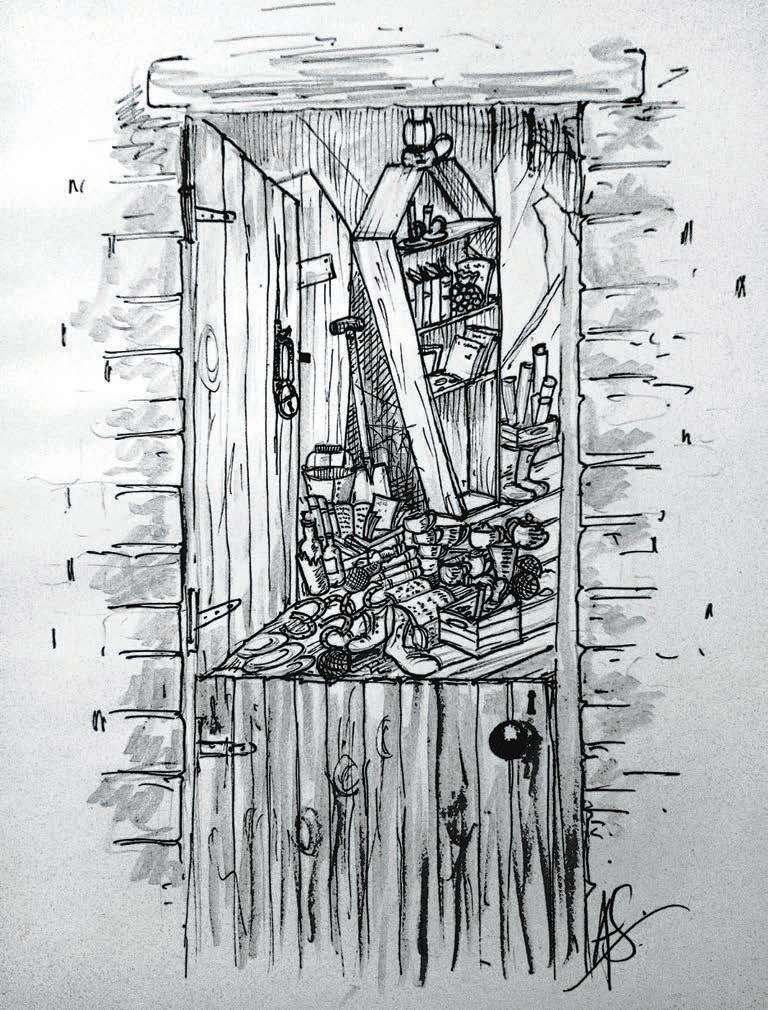
The Wake of Bryan Reilly, his last will and testament and an assault on the honour and dignity of King George
city. Amongst them was Joe Quigley from Kilmanagh who usually spent the night in a ditch under a black thorn bush counting the stars. Jack Cullen better known as the Lord of the Lough. Peter Bronnach remarkably known for the originality of his curses. Tom Crow the best bootmaker in the city but always bare footed himself. Ned Lanigan an old surveyor but an in del. Bryan himself was thought to be of the same way of thinking for he was never seen at church, mass or meeting and as he lived so did he die. He usually opened his establishment each day at eight o’clock in the morning but on this occasion it remained closed all day. Bryan, not having made any appearance since the previous day, the suspicions of the neighbours became aroused, the door was forced open towards evening and the poor old merchant was found dead in his bed.
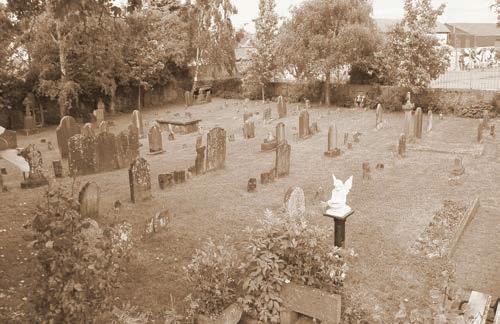
Above: St Rioch’s graveyard today. Reilly’s last will and testament stated that he wished to be buried at St Rioch’s graveyard on Walkin Street . Photo jbs photos
Left: For nearly forty years Bryan Reilly carried on his business within the precincts of his sale room for whether the weather was wet or dry the party selling or buying should stand in the street and carry on the business over the half door. (Drawing by Andrew Small)
THE LAST WILL AND TESTAMENT
A piece of paper was found on a table near his bed and it purported to be the last will and testament of Bryan Reilly. It stated that £20 would be found in the oak chest, £2 be given to the Lord of the Lough, £2 to Bronnach, £2 to Tom Crow, also that his co n would be found in the room and that the £14 remaining after the three bequests was to be applied to the expenses of his wake, which was to be kept up as long as the £14 would supply tobacco, snu and whiskey and he was then to be buried in Saint Riochs grave yard. e money was found in the chest, the co n was also found standing in an upright position furnished with shelves and appeared to have been used as a cupboard. e report of his death and the nature of his will spread rapidly through the city, when all the eccentric characters who had enjoyed the friendship of the merchant determined to respect his memory by waking him with an unusual degree of fun, frolic and whiskey. e latter being copiously indulged in, the scene soon became boisterous, and attracted the attention of Sam Prince the town constable who lived only a few doors up the street. Assuming an air of great authority he entered the wake room and commanded immediate silence or he would clear the house. ere was at that time a street ballad sung through the city on market or fair days. Sam Prince had already made many arrests for the singing of the ballad. e company knowing it to be especially annoying to the constable, the Lord of the Lough, Peter Bronnach and Tom Crow commenced to sing it. Each verse of the song ended with the line “God Damm George King” was taken up by the whole house. e constable hastily retreated but returned with his great sword to the wake. is was the signal for the renewal of the disloyal song, which he interrupted and asserted he would arrest the rst person who cursed the King’s name. e Lord of the Lough stood up and said it was George King they were talking about and not King George. Peter Bronnach then stood up and addressing the constable said: “Sam you are a petty Orangeman and I have to inform you that whether Kings name is King George or George King I won’t curse him or bless him but I pray the Holy Father to take him in his arms and pitch him to the devil.” e merriment of the company rose to boiling point, in the midst of which the constable unsheathed his long sword and made his way to arrest any of the three who had assaulted the honour and dignity of the king. As he made his way to arrest the Lord of the Lough a fellow named Kee e seized the constable’s arm by the wrist and succeeded in pulling down the arm until he got the blade of the sword at under his foot when he snapped it in two. e handle of the sword in the possession of the constable. e scene now turned into one of laughter at the sheepish appearance of the constable who retired but swearing vengeance against the enemy. He made his way to the home of his superior o cer Billy Williams, Prince stating his case with exaggerations of the attack on himself, Williams immediately ordered out the civic force. With the force marshalled the order was given to march on the wake house, take as many prisoners as possible but not to leave behind, Tom Crow, Peter Broonach and e Lord of the Lough. e three prisoners were dragged through the crowd to the street and taken to the city gaol. Having being secured for the night they awaited their trial next morning. Sin scéal eile.
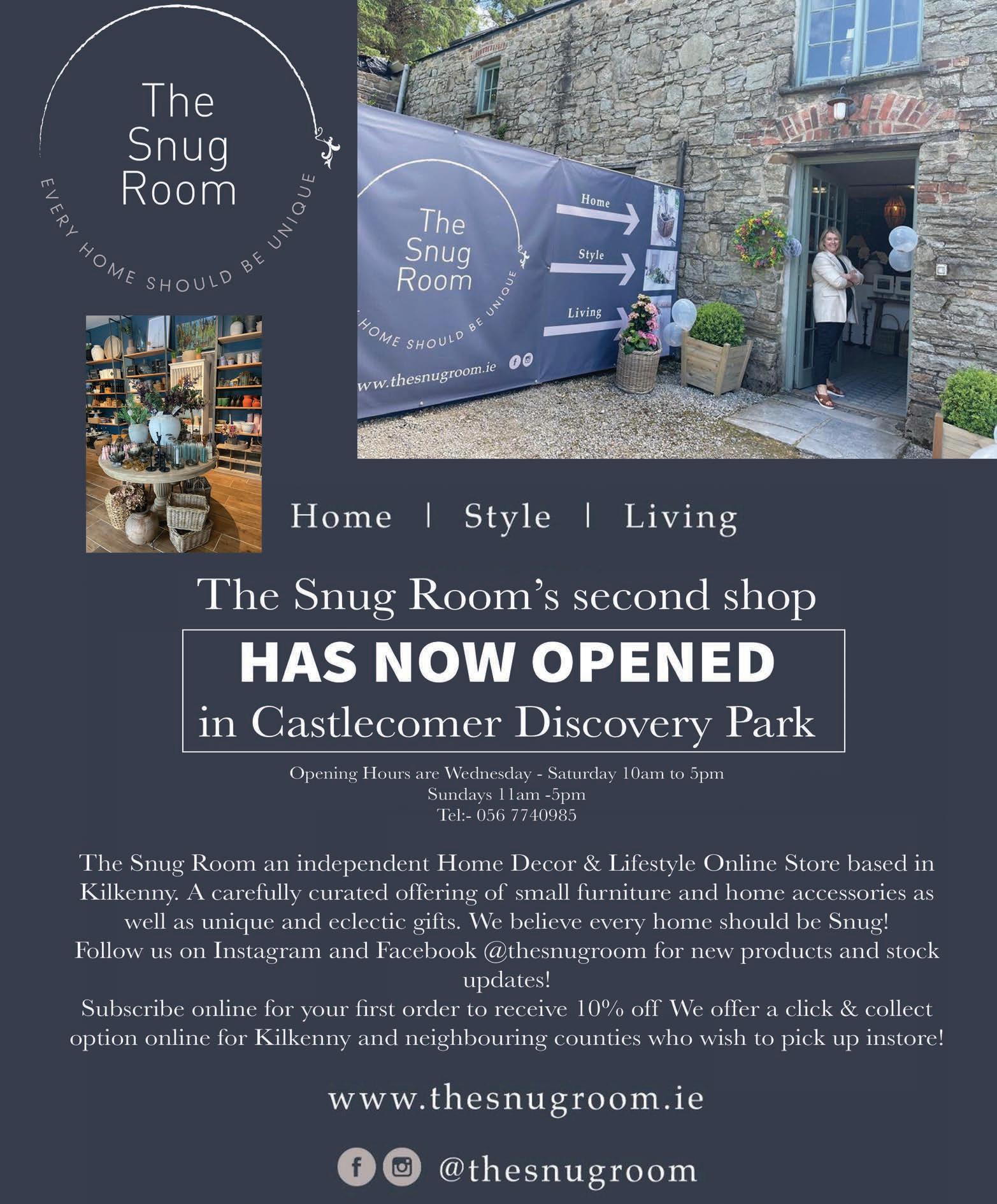

Castlecomer is venue for the story of the Leadville miners

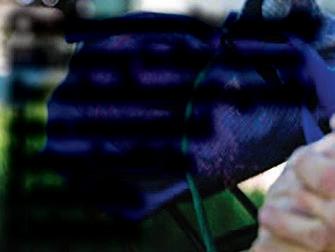
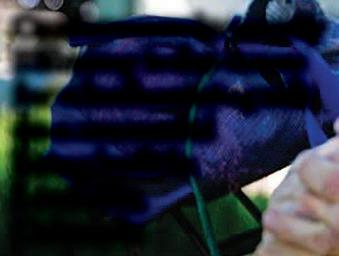
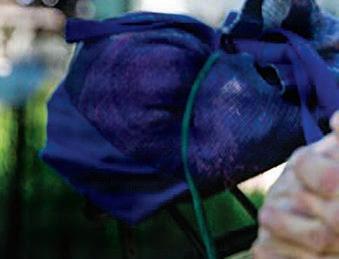
Castlecomer in county Kilkenny is the venue for a forthcoming talk on a memorial being built in Leadville, Colorado

At 10,200 Feet in Elevation, Leadville is the highest town in North America. It’s also the site of the largest and most politically important Irish immigrant communities in the Rocky Mountain West, consisting of approximately 20% of the population during the early 1880s. is working class immigrant community occupied the most di cult jobs, struggled unsuccessfully to improve their working conditions, many died very young from harsh winters, sickness, mining accidents, and epidemics. e Catholic Free section of Leadville’s Evergreen Cemetery holds the remains of thousands of Irish immigrants, buried in sunken, unmarked graves. e average age of death was twenty-three and nearly half of them are children. Today, a major memorial to these 19th century Irish immigrants is under construction, naming those in the unmarked graves and standing as a visual reminder of the human toll that industrial labour took on Irish immigrant communities across North America. Many of the graves belong to people from Castlecomer.
In the centre of the Evergreen Cemetery will be a memorial. A spiral pathway will lead to the top of a mound where a sculpture will sit. It’s reminiscent of ancient Irish burial mounds. e names of each person in the plots will be carved into glass walls or onto plaques.
Jim Walsh is an historian and researcher at Colorado University in Denver. When he was working on his doctoral thesis, he decided to focus on the Irish in Colorado.
Following a visit to a local graveyard in Leadville, his life was about to change forever.
In a section that is recognisable by what looks like snowdrifts, are 1,400 people, of di erent denominations, whose stories of trial and triumph had been lost to time. at was until Professor Walsh came upon them.
According to Jim “ e sorrow of that journey is lost. It was so traumatic that it was not passed on in oral tradition. “So this Memorial is pausing that narrative for just an instant, to turn around and just look at from whence we’ve come and that o ers us our humanity back, maybe.”
Anxious to spread the news and indeed the history of the Irish who travelled to Colorado in the 1800’s, Jim Walsh is undertaking a tour of Ireland to impart his knowledge.
One of the venues will be the Library in Castlecomer on June 21st at 6.30pm.
Booking to attend this talk can be made by phoning the library on 0564440561
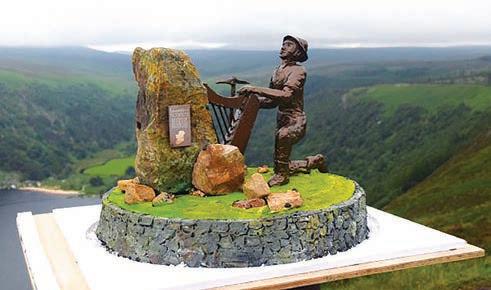

RTE Toy Show supports Twilight
e Twilight Community group, A registered Charity, once again received the support of the RTE TOY SHOW appeal for their upcoming programmes. e fund is administered by the Community Foundation of Ireland who continue to be great supporters of the groups work and activities and it is through this national institution that Twilight has quali ed for funding to run such programmes as their very popular Protecting and Assisting Senior Services (PASS) is fund will assist the group in developing physical and mental wellness of Twilight members. It will support Creative play and the very important sector of Personal Development. e group caters for all ages and backgrounds. It serves the diverse communities that have made Kilkenny their home. It assists with the Ukraine refuge crisis and a major event planned for July 3rd 2022. Just under a year ago the group began to develop their Twilight Youth Inclusion Group. TYI will bene t from the kindness and support of the RTE TOY SHOW appeal award. Twilight hold a strong believe in our youth being the future. Today’s youth or tomorrow’s leaders. With the planned activities of fun and personal development projects Twilight will give their TYI members the foundations that will one day allow its members to take full advantage of the opportunities that will come their way. at is why the Twilight Community Group are honoured that the RTE TOY SHOW appeal and the Community Foundation of Ireland believe in our Kilkenny Community group and International Cultural House programme. CEO/ Chair person Murty Brennan would like to thank the CFI & RTE and said “ If we had a bigger premises just imagine what we could do for Kilkenny” he also mentioned that 10 of the TYI members will head to Margny Les Compiegne July 16th with 10 from France and another 10 from Malbork Poland returning to Kilkenny July 23rd for seven days. is can only enhance Twilight and Kilkenny’s reputation abroad.
Twilight is an open and fully inclusive Group where all men, women, boys and girls are welcome in all the diversity





In this, the second week, e Kilkenny Observer looks at the life Of Lieutenant Colonel James Frederick Plunkett, born into a Kilkenny military Lieutenant Colonel James Frederick Plunkett, born into a Kilkenny military family, and who was to see war at rst hand in many parts of the world
Soldiers of 2nd Battalion, the Royal Irish Regiment, who survived the attack on Bellewaarde Ridge, 1915
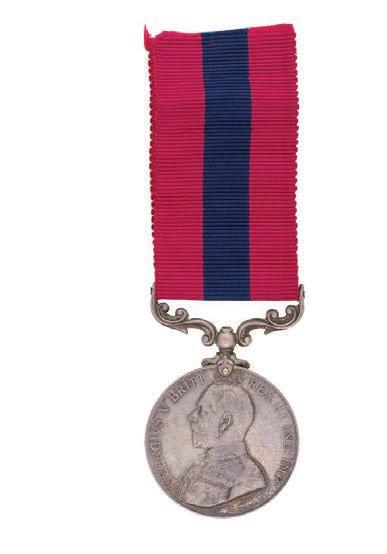
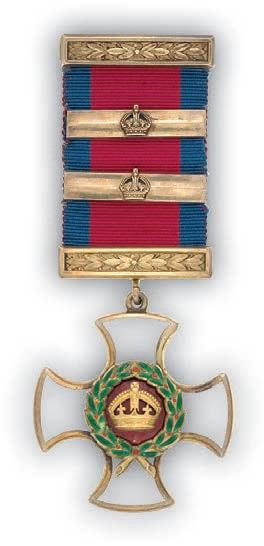
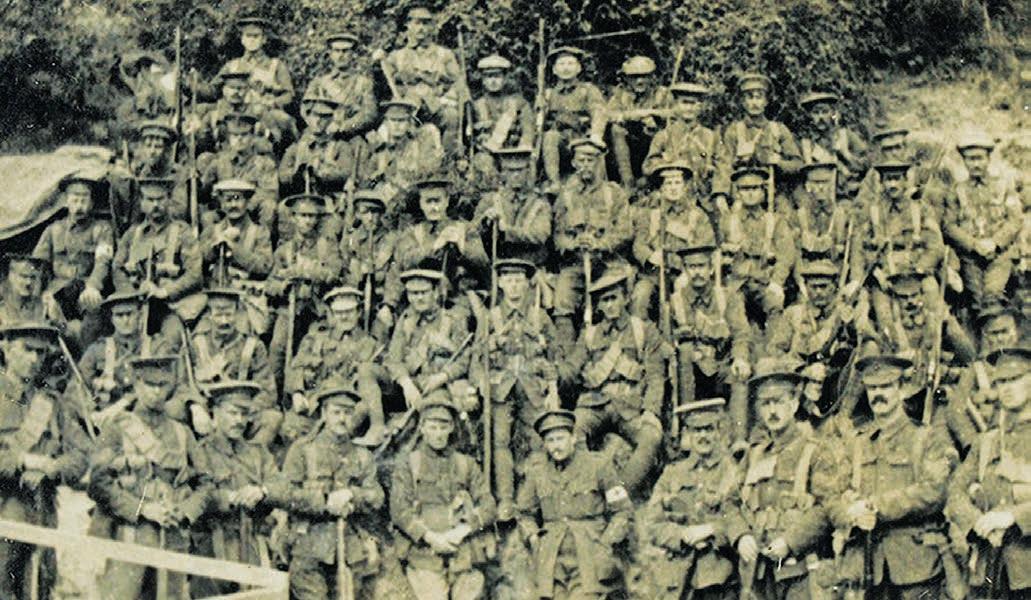
Life in the trenches
Plunkett’s indefatigable e orts throughout this grim period earned him the further reward of an o cer’s commission. ereafter, he served with a variety of units - notably including 12th Battalion e Su olk Regiment, 19th Battalion e Royal Welsh Fusiliers, and 13th Battalion e Royal Inniskilling Fusiliers - in various sectors - including Loos, Gouzeaucourt, Cambrai, and Bullecourt.
During this time, Plunkett experienced all the dangers and discomforts of life in the trenches. He stoically endured the misery of the cold, wet, mud and lice, and the ever-present threats of gas, sniping, shelling and mines.
His penchant for taking pot-shots at the rats which plagued the trenches almost resulted in a ghastly accident, when a stray bullet narrowly missed his commanding o cer.
Trench warfare
A dedicated professional soldier, Plunkett became an expert in trench warfare. He developed a special talent for the di cult and dangerous business of trench raids. ese were essential for keeping the enemy under pressure and for gathering intelligence from prisoners, but they often ended in disaster when carried out under careless or inexperienced o cers.
Plunkett not only appreciated the ner points of raiding tactics, but also the importance of leading from the front, serving as an example and an inspiration to his men. Emerging as a rst-class battalion commander, his service thoroughly merited his award of the Distinguished Service Order, bestowed upon o cers in recognition of their courage, leadership and meritorious service.
Bourlon Wood
Plunkett’s nest hour came during the Battle of Cambrai in 1917. is is famous for being the rst time that tanks were successfully employed on a large scale. e attack initially enjoyed great success, breaching the Germans’ formidable ‘Hindenburg Line’ defences and bringing in a large haul of prisoners. However, things soon went awry. e British found themselves unable to exploit their success and vulnerable in the face of a powerful German counterattack.
While the o ensive ultimately ended in failure, Plunkett and his men performed their role magni cently. ey played a prominent part in the capture of Bourlon Wood on the left ank, a feat made more remarkable by the fact that tanks and smoke shells, which had been promised to support the attack, failed to materialise. ey then held the wood for three days against a ferocious series of counterattacks, engaging in some of the most vicious close-quarter ghting of the war.
‘I have fought with many regiments in this war, but the achievements of the 19th Bn Roy Welch Fusiliers & remainder of 119 Brigade taking Bourlon Wood on 23rd November 1917, with no assistance from tanks, smoke barrages, etc, and only a few minutes preliminary artillery bombardment, capturing at least 500 prisoners with many machine guns, then repelling counter-attacks for 3 days without sleep, subsisting on iron ration food only, handing over the wood intact, marching 15 miles to the rear, after the brigade had su ered 75% casualties both in o cers and men, and nishing the last mile of the march in high spirits, I place second to none of any other.’
Plunkett on the conduct of his troops at Bourlon Wood, November 1917
Contempt of danger
Plunkett had been recommended for the Victoria Cross for his bravery at Bourlon Wood, but this was later downgraded to a bar to his Distinguished Service Order. Nonetheless, the citation to this award fully recognised the leadership and heroism that he had displayed.
Further heroics were to follow during the nal
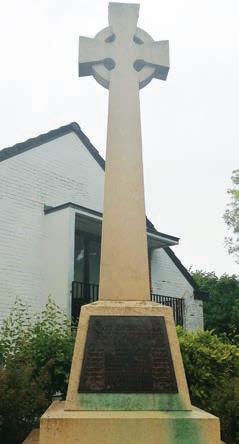
The memorial cross at Mons commemorating the o icers and men of 2nd Battalion The Royal Irish Regiment who fell in the First World War (Photo taken by Mary Anne Maher, Sec. 18th Regiment of Foot Royal Irish Regiment (& South Irish Horse) Association) 1 1 2 2
Medal 1: Distinguished Conduct Medal awarded to Regimental Sergeant Major James Plunkett, 17 December 1914
Medal 2: Military Cross awarded to Regimental Sergeant Major James Plunkett, 1 January 1915 (NAM. 1995-03-91-3 )
Medal 3: Distinguished Service Order with two bars, awarded to Lieutenant Colonel James Plunkett
victorious Allied o ensive of 1918. On 27 August, Plunkett led his battalion in a daring ank attack against a German position at Rue Pruvost, which enjoyed complete success and saw the capture of seven machine-gun posts.
For this, he was awarded another bar to his DSO, with the citation praising his ‘absolute contempt of danger’ and highlighting ‘his determination and ne personal example’ as the chief cause of their success.
‘For conspicuous gallantry and devotion to duty during sixty hours’ handto-hand ghting. When our line was pressed back by a counter-attack and the men began to waver on the right, he reorganised them and succeeded in reestablishing our old line. When reinforcements arrived, he organised and led a successful counter-attack. He carried out in person many daring reconnaissances, and undoubtedly saved the situation at many critical moments by his prompt action.’
Citation for Plunkett’s rst bar to his Distinguished Service Order, 1917
Close shaves
In the course of his service, Plunkett had innumerable close shaves. During some periods, these were almost a daily experience. On many occasions, shells landed nearby, but either failed to go o , narrowly missed him, or left him only lightly wounded. Several times, he described leaving a place only for it to be immediately obliterated by shell re.
Perhaps most remarkable was an incident at Bourlon Wood. Plunkett spotted an enemy who was about to take aim at him, but by quick thinking, lightening reactions, and sheer good fortune, he was able to take aim and get his shot o rst.
A heavy toll
Despite escaping serious injury, the war still took a heavy toll on Plunkett’s health. His many ailments included deafness and respiratory problems, as well as a heart attack.
His service at the front was interrupted by several long bouts of convalescence. At one stage, he had trouble persuading an Army medical board that he was t to return to action. And, ultimately, it was owing to poor health that he retired from the Army in 1922.
Full honours
Plunkett was clearly in his element as a front-line commander. Indeed, the end of the ghting in 1918 came as something of a disappointment to him as it prevented his promotion to brigadier-general, a rank he felt was in his grasp had the con ict continued a little longer.
He was, however, able to console himself with the cheering thought of returning to his wife and family, and the satisfaction of a job well done.
His full wartime honours were: Distinguished Service Order with Two Bars; Military Cross; Distinguished Conduct Medal; French Croix de Guerre; and ve mentions in despatches.
In May 1930, he was given the further honour of joining the Military Knights of Windsor, one of Britain’s most ancient military establishments. He resided at Windsor Castle for the next 17 years. However, as he continued to be dogged by illhealth, he was then permitted to move to Sussex, where he died in 1953 aged 75.
e Kilkenny Observer wish to thank the following for information used in this article: Mary Anne Maher, e National Army Museum, and curator at the National Army museum, Justin Saddington.
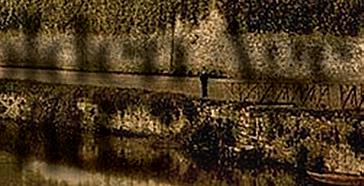
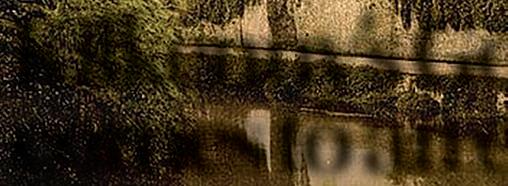
Kilkenny’s Golden Age comes to an end...
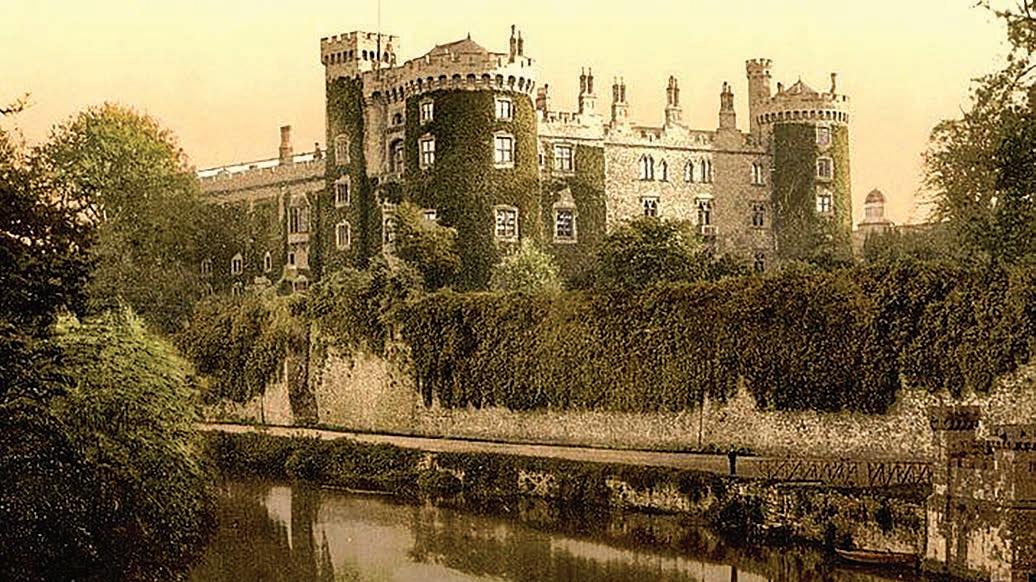
With the war in England going badly for the king, the Kilkennybased Confederate leadership decided it would be tactically wise to put aside their grievances with the Crown and support Charles against the feared Oliver Cromwell.
So in January 1649, what became known as the Second Ormonde Truce was signed to end hostilities between the Confederacy and forces loyal to the Crown. is agreement committed the Confederacy to dissolving itself.
It was to be replaced by the Commissioners of Trust and this new body would direct the Royalist war against Cromwellian forces in Ireland, uniting all factions in a bid to stave o a “Roundhead” victory. e Confederation did not convene again after January 1649.
Unfortunately, the Confederacy had not picked the winning side in the English Civil War. It was Cromwell who triumphed across the water. Just a few weeks after the Truce agreed by the Confederation, Cromwell and his henchmen put King Charles I on trial for his life at Westminster. e monarch was beheaded, and Britain’s new strongman replaced the Crown with a British Commonwealth. He ruled like a dictator until his death in 1658.
Having suppressed all opposition to his regime in Britain, Cromwell turned his attention to Ireland. He promised to avenge both the Irish uprising of 1641, in which thousands of Protestants had been massacred, and to crush the remaining Royalist forces in Ireland.
From the moment the King’s head rolled onto the oor of that grim hall at Westminster, Kilkenny’s fate was sealed.
Fourteen months later, Cromwell and his powerful army would be at the City gates. is proud centre of Irish freedom, government, and culture would be trampled into the ground. e former seat of an independent Irish parliament was destined to yield to the tyranny of occupation. Kilkenny’s Golden Age was over.
CROMWELL’S ARRIVAL
On March 22nd 1650, the city was confronted with one of the greatest threats ever to its security and wellbeing.
Kilkenny had faced, and overcome, many great challenges in the course of its turbulent history. But the countdown to its darkest hours began on a frosty day in 1650. On March 22nd of that year, a powerful military force under the command of Oliver Cromwell appeared at the city gates.
Kilkenny was a target of great strategic value to his army in Ireland. And its famed reputation as the seat of the rebel Confederacy elevated its importance and status even higher in the estimation of Cromwell and his anti-royalist forces.
James Butler, the Earl of Ormond, was Lord Lieutenant of Ireland and in command of all the forces battling Cromwell’s invading army. He allocated command of his men in Leinster to Lord Castlehaven. Castlehaven in turn had appointed James Walsh governor of Kilkenny Castle and Sir Walter Butler governor of the city.
In the weeks preceding his arrival at the city gates, a combination of plague sickness and low morale among Royalist troops had weakened the defending Kilkenny garrison. Lord Castehaven had reinforced the garrison with 1000 foot soldiers and 200 horsemen, but half of these had died of plague by the eve of the siege, and less than half of these, around 300, were ghting t.
Lord Dillon’s army, a force of 1,500 foot and 600 horse; could have greatly augmented the ranks of the defenders. But these men atly refused to come to Kilkenny’s defence. ey saw resistance to Cromwell as hopeless...
John Fitzgerald Continued next week...

Rith Beo’s Perfect 10
On Sunday 29th May 2022 crowds of people descended onto the quiet carpark of Gaelscoil Osraí, each for their own reasons. Some were there to complete a chipped 5K race and get a new personal best, some were there to tackle a serious and tough chipped 10K route. Others were there to enjoy the 3K Family Fun Run, eat ice cream and bask in the glorious sunshine.
As the sun beamed down from the blue sky Donna Dunne started an energetic and soul lifting warm up - our rst since 2019, due to Covid restrictions. At approximately 10:15 mothers, fathers, brothers, sisters, grandparents, babies, buggies and dogs took to the start line and headed in mass out the gate and up along the Waterford Road to complete the annual Rith Beo 3K Family Fun Run. e grounds of the Gaelscoil were quiet again momentarily!
Within minutes again a steady stream of runners began to ll up the carpark as they came to register for the chipped races, collect their numbers and examine the maps around the school displaying the routes. It wasn’t long before the grounds of the Gaelscoil were awash with athletes waiting patiently for their individual races to begin. At 11:00am the 10K racers took to the post and were o . ere was a ne spread of runners and they were about to embark on one of the toughest courses in the locality. Who knew Kilkenny was so hilly!?
e 5K runners were next o at the post. ey hit the Outrath Road with a steady pace gently progressing along the Waterford Road with Pat Kavanagh rst to cross the nish line at 17.22 minutes. It would be another 20 minutes before the rst person crossed the 10K nish line- Paddy Walsh at 38.19 minutes. e winners and nishers continued to race home for the next hour. ey were welcomed over the nish line by pupils from the school and other supporters, claps, cheers, cold drinks, fruits and snacks. As each nisher crossed the line they were presented with their very own bespoke Rith Beo medal marking the race’s 10th edition.
Rith Beo 2022 was a huge success. Hosting it as a real event after 2 years of virtual running made the organising and hard work worth it all. e organising committee and the entire school community would like to thank the sponsors, Daly Farrell Chartered Accountants, Tip Top Toes Shoe Fitting Specialists, Fran Grincell Properties and Tower and Castle, John Street Kilkenny. Without these generous sponsors Rith Beo 2022 would not be possible. ey would also like to thank the people who gave their time so generously and volunteered as stewards on the day. ese are the people who make the race safe and possible for us all to enjoy. To all the people who donated food for the big spread in the school halla, to the people who donated spot prizes, to those who donated on the GoFundMe page, followed, liked and shared the pages on social media, spoke about Rith Beo and supported it in any way they could, the committee thanks you from the bottom of their hearts.
Rith Beo Fun Run will continue past it’s 10th year with the help and support of the local and wider community. Since its inception in 2013 over 100,000 euro has been raised with all monies going to fund the development of facilities such as the astro turf, the playground and the library to name but a few in the school.
You can still support our fundraising e orts by donating to our GoFundMe page; https://gofund.me/8c4b6477 or by signing up to do our race virtually. Follow us on Instagram and Facebook; Rith_beo_fun_run for the link on how you can get your hands on one of our beautifully crafted bespoke medals.












